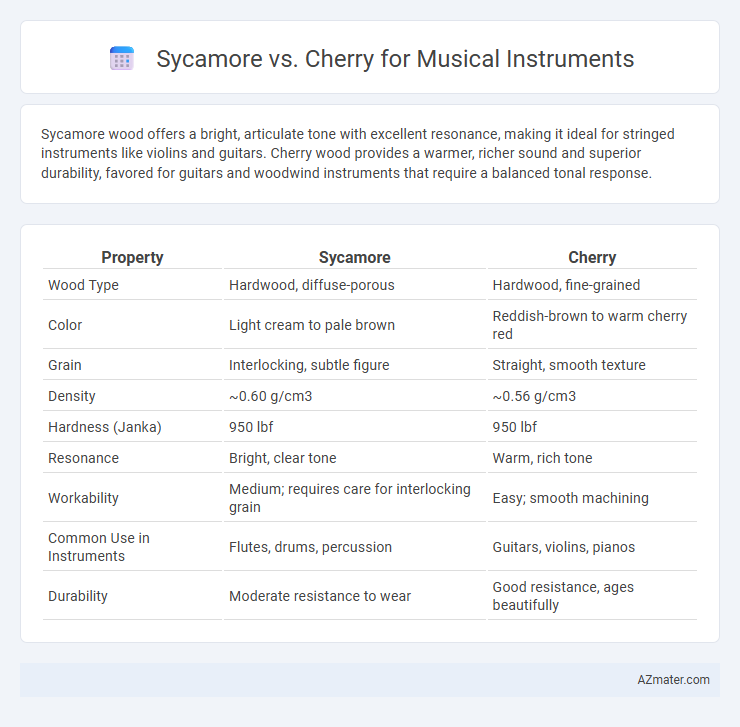Sycamore wood offers a bright, articulate tone with excellent resonance, making it ideal for stringed instruments like violins and guitars. Cherry wood provides a warmer, richer sound and superior durability, favored for guitars and woodwind instruments that require a balanced tonal response.
Table of Comparison
| Property | Sycamore | Cherry |
|---|---|---|
| Wood Type | Hardwood, diffuse-porous | Hardwood, fine-grained |
| Color | Light cream to pale brown | Reddish-brown to warm cherry red |
| Grain | Interlocking, subtle figure | Straight, smooth texture |
| Density | ~0.60 g/cm3 | ~0.56 g/cm3 |
| Hardness (Janka) | 950 lbf | 950 lbf |
| Resonance | Bright, clear tone | Warm, rich tone |
| Workability | Medium; requires care for interlocking grain | Easy; smooth machining |
| Common Use in Instruments | Flutes, drums, percussion | Guitars, violins, pianos |
| Durability | Moderate resistance to wear | Good resistance, ages beautifully |
Sycamore vs Cherry: Overview for Musical Instruments
Sycamore offers a pale, fine-grained texture that delivers bright, clear tonal qualities favored in stringed instruments and percussion, providing strong resonance and durability. Cherry wood, characterized by its rich reddish hue and smooth grain, produces warm, mellow tones with excellent sustain, commonly used in guitar bodies and woodwind instruments. Choosing between sycamore and cherry depends on the desired sound profile and aesthetic, with sycamore excelling in projection and clarity, and cherry prized for its tonal warmth and visual appeal.
Physical and Acoustic Properties
Sycamore wood features a fine, even texture and moderate hardness, providing a bright, clear tone with excellent sustain for musical instruments. Cherry wood offers a warmer, richer sound due to its denser grain and higher resonance, often favored for its smooth midrange frequencies. Both woods deliver distinct acoustic properties, with sycamore enhancing projection and cherry adding warmth and depth to instrument sound quality.
Tonal Characteristics Comparison
Sycamore offers a bright, clear tone with pronounced midrange frequencies, making it ideal for sharp, articulate sound in musical instruments. Cherry wood provides a warmer, richer tone with smooth, balanced mids and a slightly softer attack, enhancing the resonance and sustain. Musicians seeking clarity and brightness may prefer sycamore, while those favoring warmth and depth often choose cherry for guitars, violins, and woodwind instruments.
Workability and Luthier Preferences
Sycamore offers excellent workability due to its medium density and fine grain, allowing luthiers to carve and shape intricate details with ease, which is why it is favored for guitar backs and sides. Cherry, valued for its stability and smooth sanding properties, provides a warm tonal quality and is preferred by luthiers for necks and smaller instrument components. While sycamore's open grain requires filling for a smooth finish, cherry's closed grain delivers a naturally polished surface, influencing luthier choices based on the desired aesthetic and tonal characteristics.
Durability and Longevity
Sycamore wood offers exceptional durability with its dense, hard grain, making it highly resistant to wear and ideal for musical instruments subjected to frequent use. Cherry wood, while softer, provides a smooth finish and improves in tonal quality over time, but it may be more prone to dents and scratches compared to sycamore. For longevity, sycamore's robust cellular structure ensures a longer lifespan under various environmental conditions, whereas cherry requires more careful maintenance to preserve its aesthetic and acoustic properties.
Weight and Density Differences
Sycamore is generally heavier and denser than cherry wood, making it less resonant but more durable for certain musical instrument components. Cherry wood's lower density contributes to a lighter instrument with warmer tonal qualities and enhanced resonance. The weight difference influences playability and sound projection, with sycamore often favored for percussion instruments and cherry preferred in stringed instrument bodies.
Aesthetic Appeal: Grain and Color
Sycamore wood features a pale, creamy color with intricate, wavy grain patterns that create a striking visual texture ideal for musical instruments seeking a unique, eye-catching appeal. Cherry wood offers a warm, reddish-brown hue that deepens over time, showcasing a smooth, consistent grain that exudes classic elegance and timeless beauty. Both woods enhance aesthetic appeal, with sycamore delivering bold, textured patterns and cherry providing rich, warm tones favored in traditional instrument craftsmanship.
Cost and Availability in the Market
Sycamore wood is generally more affordable and widely available than cherry, making it a popular choice for musical instrument manufacturers on a budget. Cherry wood tends to be pricier due to its rich color and fine grain, and it is less abundant in the market, which can limit supply for high-end instruments. Both woods offer good tonal qualities, but cost and availability often make sycamore the preferred option for mass production.
Common Instrument Applications
Sycamore wood is favored for drum shells and piano veneers due to its bright tonal qualities and strong grain pattern, providing durability and resonance. Cherry wood is commonly used for string instruments like guitars and violins because it offers a warm tone with smooth grain, enhancing sound quality and aesthetic appeal. Both woods serve essential roles in instrument crafting, with sycamore excelling in percussion and cherry preferred for stringed instruments.
Choosing the Right Wood for Your Sound
Sycamore offers a bright, clear tone with excellent sustain, making it ideal for fingerstyle guitar and instruments requiring articulate sound projection. Cherry wood provides a warmer, richer timbre with balanced midrange frequencies, preferred by musicians seeking a smooth, mellow tone. Selecting between sycamore and cherry depends on the desired sound profile, where sycamore enhances brightness and clarity, and cherry emphasizes warmth and resonance.

Infographic: Sycamore vs Cherry for Musical Instrument
 azmater.com
azmater.com